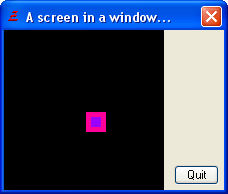If AutoStretch is 1, then the screen area will automatically resize (and its contents will be zoomed to new screen size) when the window size changes.
RightOffset and BottomOffset are used to define a margin on the right and bottom of the window (for statusbar for example).
The opened screen is created with 2 video buffers to allow you to do double buffering, especially useful for games. The buffers can be manipulated with the FlipBuffers() command.
If the screen fails to open, the result is '0'.
Note: Only one windowed screen can be opened at one time.
Example 1: (fixed screen size with gadgets)
If InitSprite() = 0
MessageRequester("Error", "Can't open screen & sprite enviroment!", 0)
End
EndIf
If OpenWindow(0, 0, 0, 220, 160, "A screen in a window...", #PB_Window_SystemMenu | #PB_Window_ScreenCentered)
If CreateGadgetList(WindowID(0))
ButtonGadget(0, 170, 135, 45, 20, "Quit")
EndIf
If OpenWindowedScreen(WindowID(0), 0, 0, 160, 160, 0, 0, 0)
CreateSprite(0, 20, 20)
If StartDrawing(SpriteOutput(0))
Box(0, 0, 20, 20, RGB(255, 0, 155))
Box(5, 5, 10, 10, RGB(155, 0, 255))
StopDrawing()
EndIf
Else
MessageRequester("Error", "Can't open windowed screen!", 0)
End
EndIf
EndIf
direction = 2
Repeat
; It's very important to process all the events remaining in the queue at each frame
;
Repeat
Event = WindowEvent()
Select Event
Case #PB_Event_Gadget
If EventGadget() = 0
End
EndIf
Case #PB_Event_CloseWindow
End
EndSelect
Until Event = 0
FlipBuffers()
ClearScreen(RGB(0, 0, 0))
DisplaySprite(0, x, x)
x + direction
If x > 140 : direction = -2 : EndIf
If x < 0 : direction = 2 : EndIf
Delay(1)
ForEver

Example 2: (screen with enabled auto-stretch and bottom-offset feature)
If InitSprite() = 0
MessageRequester("Error", "Can't open screen & sprite enviroment!", 0)
End
EndIf
If OpenWindow(0, 0, 0, 320, 140, "A screen in a window...", #PB_Window_SystemMenu|#PB_Window_SizeGadget|#PB_Window_ScreenCentered)
If CreateStatusBar(0, WindowID(0))
AddStatusBarField(320)
StatusBarText(0, 0, "Automatically zoomed screen area when changing window size...")
EndIf
If OpenWindowedScreen(WindowID(0), 0, 0, 1, 1, 1, 0, 20) ; we don't need exact screen width/height, because it will be automatically stretched...
Else
MessageRequester("Error", "Can't open windowed screen!", 0)
End
EndIf
EndIf
Repeat
; It's very important to process all the events remaining in the queue at each frame
;
Repeat
Event = WindowEvent()
If Event = #PB_Event_CloseWindow
End
EndIf
Until Event = 0
FlipBuffers()
ClearScreen(RGB(0, 0, 200))
Delay(1)
ForEver

For a more detailed example look at
WindowedScreen.pb